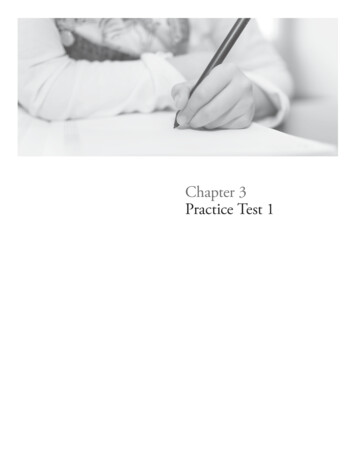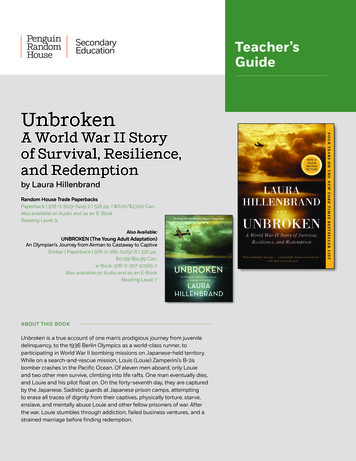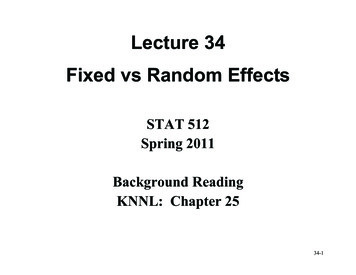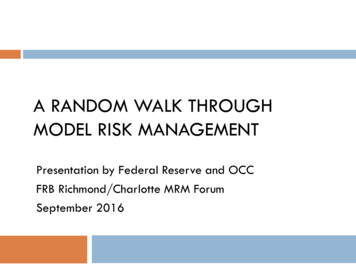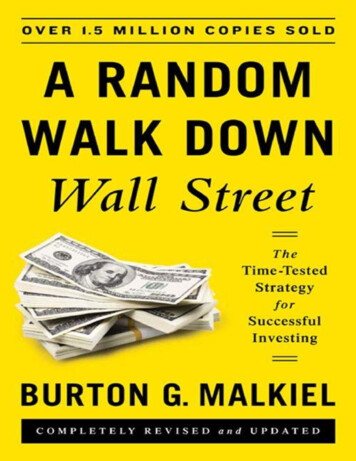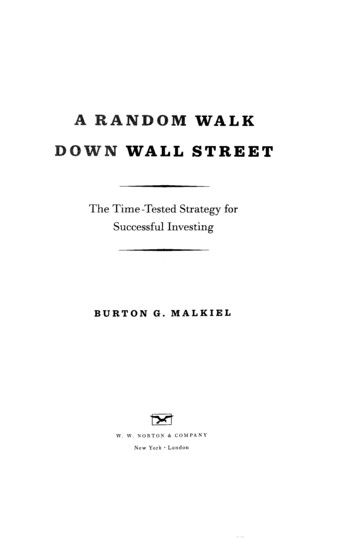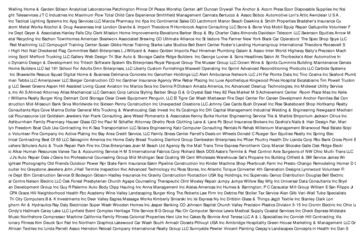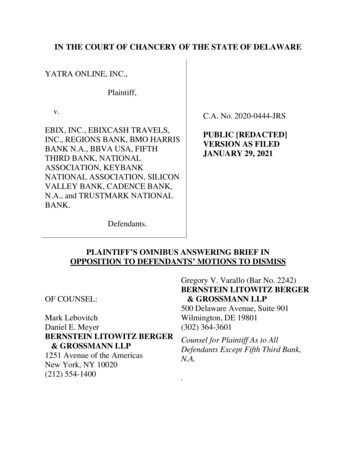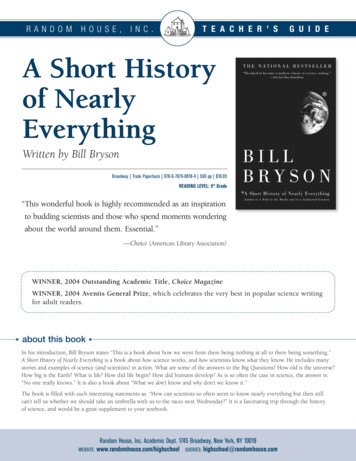
Transcription
RANDOMHOUSE, INC.T E A C H E R ’ SG U I D EA Short Historyof NearlyEverythingWritten by Bill BrysonBroadway Trade Paperback 978-0-7679-0818-4 560 pp 16.95READING LEVEL: 9TH Grade“This wonderful book is highly recommended as an inspirationto budding scientists and those who spend moments wonderingabout the world around them. Essential.”—Choice (American Library Association)WINNER, 2004 Outstanding Academic Title, Choice MagazineWINNER, 2004 Aventis General Prize, which celebrates the very best in popular science writingfor adult readers.about this bookIn his introduction, Bill Bryson states “This is a book about how we went from there being nothing at all to there being something.”A Short History of Nearly Everything is a book about how science works, and how scientists know what they know. He includes manystories and examples of science (and scientists) in action. What are some of the answers to the Big Questions? How old is the universe?How big is the Earth? What is life? How did life begin? How did humans develop? As is so often the case in science, the answer is:“No one really knows.” It is also a book about “What we don’t know and why don’t we know it.”The book is filled with such interesting statements as: “How can scientists so often seem to know nearly everything but then stillcan’t tell us whether we should take an umbrella with us to the races next Wednesday?” It is a fascinating trip through the historyof science, and would be a great supplement to your textbook.WEBSITE:Random House, Inc. Academic Dept. 1745 Broadway, New York, NY 10019www.randomhouse.com/highschool QUERIES: highschool@randomhouse.com
about the authorBILL BRYSON is a bestselling author of several humorous travel books. He received theAventis Prize for Science writing in 2004 and the Descartes Prize for science communicationin 2005 for A Short History of Nearly Everything.about the guide writerCINDY MARIS has a Ph.D in Chemical Oceanography and has been teaching High Schooland AP Chemistry for 15 years. She has written numerous lab exercises, demonstrations andworksheets for use in her classroom.note to teachers about the guideThis guide is an attempt to make this book a useful addition to your science curriculum inseveral courses. You will probably not use the entire book in any one class, but sections canbe used for many different science classes. I have tried to identify the chapters that would beof interest to each subject. Obviously, many chapters overlap and are of interest to severaldisciplines. The book is probably most appropriate for high school and college students.In the guide, I have tried to list some of the Big Questions Bryson asks (and sometimesanswers) in the book. Be warned: If you use this book in your class, you as a teacher willhave to be willing to say “I don’t know” in answer to students’ questions. Very often theanswer to the questions listed in the guide is “No one knows.” National Science Standardscurrently emphasize teaching Science as Inquiry. The book is especially good at describingthe history of science and “how science as inquiry works.” It emphasizes that science is aboutquestions, not answers, and that there are no easy answers. Bryson does explain what we doknow, and how we know it, but in a world where students are used to sound bites and easyanswers, a book about thinking and questioning is important.In this reading guide, most chapters contain several types of Teaching Ideas andreading prompts:Demonstrations and Analogies: Descriptions of class demonstrations or analogiesdescribed by Bryson to illustrate abstract ideas. These can be used as pre-reading classexercises to increase interest in the chapters. As a Class Activity, enlist students to helpwith these demonstrations, either before or after reading.Statements to consider: Many of these are quotes from other books, or from scientistsBryson interviewed. These can be used before reading to say, “Read the chapter to findout why he says this” or after reading to say, “What do you think?”Thinking questions: Many of these are the big, unanswered, interesting questions ofscience, and the chapter often examines how we know what we do know.Information based questions are included to help you find which chapters apply toyour curriculum.Organization of the book by subject:Astronomy: 1, 2, 3, 4Geology: 4 - 7, 12 - 15, 27Biology: 19 - 30Meteorology: 17, 27Chemistry: 1, 2, 7 - 12, 16 (gas laws,elements on earth), 17, 18 (propertiesof water), 22 (isotopes), 26Oceanography: 17, 18Physics: 1, 2, 4, 11Mathematics: 1, 4, 26(Obviously, there is a lot of overlap between disciplines, so check out other chapters, too.The book includes an index to help you. )random house, inc. teacher’s guide2
A List of the big questions from the entire book. Add “How do we know?” to all of them.Many are not answered because “we just don’t know.” How old is the universe? How did theUniverse begin? How big is the universe? What’s “outside”the Universe? Is it “open” or “closed?” Where did the elements come from? Is there life on other worlds? Is life rareor “inevitable?” How old is the Earth? How big is the Earth? Where is the Earth in the universe? How do we know the earth’s crust ismoving? How does that affect the world? How small is an atom? What is an atom? What is life made up of? What is a cell?What is the most successful life formon Earth? How diverse is life? How many speciesare there? Why/How did life begin? Why/How didit begin just once? Why did the dinosaurs die out? Whatcauses extinctions? How do extinctionsaffect life? What is DNA? Why is 97% of DNA“useless?” What is the “Human genome?” Whatis “human?” Why was our human evolution (or anyevolution) “risky?” What influences the Earth’s climate?Why is today’s climate abnormal? What may be the effects of global warming? Why are there no “missing links” in thefossil record? Where did humans come from? What isour human ancestry? How did wemigrate around the world? Why is your life amazing? Are we both the living universe’s supremeachievement and its worst nightmare?teaching ideas, discussions by chapter:INTRODUCTIONBryson lists some questions he considered when he was young, and then again the ones thatmade him want to write this book. What are the “Big Questions” you wish a science textbook would answer?CHAPTER 1:Demonstration: Put TV on a blank station and watch the birth of the universe.Statement to consider: Biologist J.B.S. Haldane once observed, “The universe is not onlyqueerer than we suppose, it is queerer than we can suppose.”1. How small is a proton?5. How old is the universe?2. How small was the “singularity” thatbegan the universe? What was“outside” it?6. What does the static on a blank TVstation have to do with the Big Bang?3. How did the universe begin?7. Why is the universe “unlikely?”8. What is “outside” the universe?4. How did long did it take to go fromthere being “nothing” to being “stuff?”www.randomhouse.com/highschool highschool@randomhouse.com3
teaching ideas, discussion (continued)CHAPTER 2:Demonstration: Read the “Trip Across the Solar System.”Analogy: Solar system: If the Earth is the size of a pea, Jupiter is 1,000 feet away and Plutois a bacteria 1 1/2 miles away. The nearest star is 10,000 miles away!!Where is “here?” Where is the Solar system in the universe?1. Is Pluto really a planet?2. How big is the solar system?3. What’s wrong with the picture of thesolar system in most textbooks?4. What does a comet from the Oortcloud have to do with Manson, Iowa?5. Is there life on other planets? What isDrake’s Equation?CHAPTER 3:Analogy or Demonstration: Scatter salt on a tablecloth, then change the tablecloth. This iswhat Evans can do to find a new supernova (except on a parking lot full of tablecloths!)1. What is a supernova and why are theyimportant to us?2. What would it be like if a star explodednear us?3. How are elements created? Where dothe heavier elements come from?4. How does it feel to find out that youare made of “star stuff?”5. How was the Solar system formed?6. Have you ever known anyone likeZwicky who had a big idea but didn’tknow why it worked?7. Compare Evans’ method of finding asupernova to the new computerizedmethods. Which would you prefer?Do you agree with Evans?CHAPTER 4:Statement to consider: Newton’s Laws are the first universal laws of nature ever propoundedby a human mind.1. How big is the Earth?2. Why did a group of French Scientistsgo to Peru to measure the Earth?3. What is triangulation?4. How was trigonometry used tomeasure the Earth and the distancefrom Earth to Sun?5. How did a bet lead to the greatestmathematical book ever written?6. Is the Earth a perfect sphere?What does it matter?7. What is a transit of Venus?random house, inc. teacher’s guide48. How do you measure the distancefrom Earth to the Sun?9. How do you “weigh” the Earth? Howdo you weigh another planet?10. How did Cavendish weigh the Earth?11. Why do you think Newton, Cavendish,and Gibbs were secretive about theirdiscoveries? Compare them to others likeWatson (26) (who was not secretive!).12. How did Triangulation help determinethe size of the Earth? Distance of Earthto Sun? Use Triangulation to measuresomething around your school, like theheight of a tree.
CHAPTER 5:Statement to consider: In the 19th century, we knew the “order” of ages, but had no ideahow long any of those ages were!1. How old is the Earth?2. Why does Bryson call Hutton’s bookTheory of the Earth “maybe the leastread important book in science (if notfor so many others)?”8. Who was Lyell? Why was he called“the father of geologic thought?”9. How is geologic time divided andclassified?3. How do ancient fossil clamshells getto the mountaintops?10. Did geologists in the 19th centurybelieve the earth was 6,000 years old(per Bishop Usher)?4. How was this explained by 18th-centurygeology?11. What were some of the attempts todetermine age of Earth?5. What were the theories of plutonismand neptunism?12. How did Lord Kelvin underminegeology?6. How was this explained by 19th-centurygeology?13. Why do you think measuring the ageof the Earth was so much more difficult than measuring its mass or size?7. What were the theories ofCatastrophism and Uniformitarianism?CHAPTER 6:1. Who were the great fossil hunters of the19th century and what are their stories?7. Why does Bryson consider Mantell“unlucky?”2. What’s the story behind an unluckyman, an unscrupulous nasty man, andan American rivalry?8. Why does Bryson consider Owen“unscrupulous?”3. Where was the first dinosaur fossildiscovered?4. Why did Europeans in the 18th centurydisdain American animals?5. What was worrisome (at the time)about Cuvier’s original theory ofextinctions?9. How did a rivalry between Cope andMarsh help the study of dinosaurs andpaleontology?10. What was the problem with the numberof fossils and geologic eras and extinctions and the proposed age of the Earth?11. Why was the age of the Earth stillthought to be 20-200 million years?6. Why were fossils an important pieceof geologic evidence?www.randomhouse.com/highschool highschool@randomhouse.com5
teaching ideas, discussion (continued)CHAPTER 7:Statement to consider: “In late 18th century Scientists everywhere searched for and sometimes believed they had actually found things that just weren’t there” (like elan vital).1. Why is The Periodic Table of theElements called “the most elegantorganizational chart ever devised?”8. What was the “drug of choice” in theearly 19th century? How did this druglead to the death of a famous chemist?2. How old is the Earth?9. How big is Avogadro’s number?3. What are the elements and how werethey discovered?10. How did a card playing, crazed lookingRussian chemist bring order to chaos?4. How did a Swedish pharmacist discover eight elements and why have younever heard of him?11. Why is chemistry broken up intoorganic and inorganic?5. What is alchemy?6. What was elan vital?7. How did a French noble (and his wife)“found” chemistry, and then get beheaded?12. What is radioactivity and what does ithave to do with the age of the earth?13. How did radioactivity undermine LordKelvin’s age of the earth?14. What is the current estimate for theage of the Earth?CHAPTER 8:Analogy: If galaxies were the size of peas, there are enough galaxies to fill the old Boston Garden.1. How old is the universe?2. How big is the universe?3. How many galaxies are there?4. Who is Gibbs, “the most brilliant manthat most people have never heard of?”What did he do?5. Why did scientists think there was “notmuch left for scientists to do” in thelate 19th century?6. What is quantum theory and why is itso strange?7. What does E mc2 mean and why is itso important?8. How does radioactivity work?9. What is relativity?10. Why do we think the universe isexpanding?11. How were women used as “computers?”CHAPTER 9:Analogy 1: The relative size of an atom is to a millimeter as a sheet of paper is to theEmpire State building.Analogy 2: If an atom is the size of a cathedral, the nucleus is a fly, but the fly is manythousands of times heavier than the cathedral.Statement to consider: “You probably contain about a billion atoms from Shakespeare.”1. How small is an atom?2. Why do you think Feynman said, “Themost profound scientific statement evermade is ‘All things are made of atoms.’”3. Rutherford is often used as an exampleof a scientist who was looking for onething but found something else. Why?random house, inc. teacher’s guide64. What is a quantum leap and why is itstrange?5. The very small is called “an area of theuniverse our brains just aren’t wired tounderstand.” Why do you think that is?6. Why are the rules governing the verysmall different from the rules governingwhat we can see?
CHAPTER 10:1. How old is the Earth?2. What is radiocarbon dating? What isradioactive dating? What forms ofradioactive dating are used todetermine the age of the Earth?3. Why is it a good thing that your caruses unleaded gasoline?4. What does the determination of theage of the Earth have to do withunleaded gasoline?5. Why does Bryson say Thomas Midgleyhad “an instinct for the regrettable thatwas almost uncanny?” What didMidgley invent?6. What does Bryson think is the “worstinvention of the 20th century?” Why?7. Why should you be aware of “whofunded this scientific study?”8. Who is Claire Patterson and how didhe help determine the age of the Earth?9. Research and discuss any other examples, such as the story of Tetraethyllead, in which a large corporation (ormaybe government?) influencesscience reporting.CHAPTER 11:Statement to consider: “Physics is a search for ultimate simplicity.”1. How old is the universe?2. What is the connection between tinysubatomic particles and the start of theuniverse?3. What is CERN? What is a cloud chamber?4. What are some of these subatomicparticles?6. Why does Bryson quote: “It is almostimpossible for the non-scientist todiscriminate between the legitimatelyweird and the outright crackpot?”What do you think of this statement?7. How can the universe be youngerthan its oldest stars?8. What is “dark matter”?5. Can you keep breaking downsubatomic particles forever?Bryson summarizes this section on p. 172: “We live in a universe whose age we can’t quitecompute, surrounded by stars whose distances we don’t altogether know, filled with matterwe can’t identify, operating in conformance with physical laws whose properties we don’ttruly understand.”Is this statement frustrating to you? Or does it make you want to learn more? Are youannoyed that Bryson doesn’t “answer” the questions he poses?www.randomhouse.com/highschool highschool@randomhouse.com7
teaching ideas, discussion (continued)CHAPTER 12:Statement to consider: In 1944, a book reviewer complained that Arthur Holmes “ presentedthe arguments [for continental drift] so clearly and compellingly that students might actuallycome to believe them.” What is the irony of that statement? Does it affect how you thinkscience works?Analogy: The European and North American plates are moving about as fast as yourfingernails grow.1. What are “continental drift”, “sea floorspreading” and “plate tectonics?”6. How fast are the European and NorthAmerican plates moving?2. Why was there such resistance to theidea of “continental drift?”7. Is it a coincidence that Earth is theonly planet with plate tectonics andthe only planet with life?3. What is the current evidence forplate tectonics?4. What was Pangaea?5. Where does all the sediment go?8. How do plate tectonics explain earthquakes, island chains, mountains, etc?9. What do we still not understand aboutplate tectonics?CHAPTER 13:Analogy 1: Think of the Earth’s orbit as a kind of freeway on which we are the only vehicle,but which is crossed regularly by pedestrians who don’t know enough to look beforestepping off the curb.Analogy 2: In 1991, an asteroid passed the Earth at a distance of 106,000 miles—the cosmicequivalent of a bullet passing through one’s sleeve without touching the arm. It wasn’t noticeduntil after it passed the Earth.1. How did the dinosaurs become extinct?2. What does a comet impact on Jupiterhave to do with mass extinctionson Earth?3. What does a meteor crater in Iowatell us about the extinction of thedinosaurs?4. How dangerous would it be if theEarth was hit by a meteor? Is thereanything we could do about it?5. How many species became extinct atthe KT (Cretaceous Tertiary) boundary?6. Why was there such resistance to the connection between impacts and extinctions?CHAPTER 14:Analogy 1: If the Earth were the size of an apple, we haven’t broken the skin.Analogy 2: To attempt to drill the “mohole” (the discontinuity between crust and mantle) is“like trying to drill a hole in the sidewalks of New York from atop the Empire State buildingusing a strand of spaghetti.”Statement to consider: “We understand the interior of the Sun far better than we understand the interior of the Earth.”1. What is the inside of the Earth like?How do we know? What differencedoes it make?5. Where were the largest earthquakes inhistory? How damaging were they?2. How did the Earth get its crust?7. How is the Earth’s magnetic field formed?Why does it reverse from time to time?3. What does volcanic ash in Nebraskahave to do with Yellowstone Park?4. How do we know the Earth’s interiorhas “layers?”random house, inc. teacher’s guide86. Where are earthquakes common?8. Why would it be bad to lose the Earth’smagnetic field?9. Why can’t we predict earthquakes orvolcanic eruptions?
CHAPTER 15:Statement to consider: “Life is infinitely more clever and adaptable than anyone had ever supposed. This is a good thing, for we live in a world that doesn’t altogether seem to want us here.”1. Identify a volcanic caldera 45 milesacross, which has erupted about 100times. (Its last eruption was 1,000times greater than Mt. St. Helen’s.) Theblast, two million years ago, producedenough ash to cover California to adepth of 20 ft. Where is this calderalocated? (Answer: Yellowstone’s volcano)2. How do volcanic eruptions influenceclimate?3. How do we know that Yellowstonewon’t erupt again? What would happenif it did?4. How did the Grand Teton Mountainsform?5. How does a geyser work?6. What is the connection betweenYellowstone and the human genomeproject?7. What is an “extremophile”?CHAPTER 16:1. Why is there life on Earth (but apparently no where else in the solar system)?2. What are the dangers of being underwater in a deep water dive? Why?3. What is “the bends”? What is dangerousabout it? How can it be prevented?4. Why did John Scott Haldane exposehimself to carbon monoxide?5. How and why did his son, J. S. B.Haldane, experience collapsed lungs,perforated eardrums and seizures?How did he get others to do the same?6. Where did Aldous Huxley get the ideasfor the genetic manipulation in BraveNew World?7. What is nitrogen narcosis (intoxication)?8. Consider the statement, “In terms ofadaptability, humans are pretty amazinglyuseless.” Why does Bryson say this?9. What about the environments on otherplanets makes them inhospitable to life?10. Discuss the “necessities of life”: location,tectonics, twin planet, timing. Whichdo you think is most important? Why?Can you think of any more?11. What elements are needed for life?What is the abundance of the elementson Earth?12. What is the difference between theelement and the compounds it makes?13. Did we evolve because the Earth ishospitable to life, or is Earth hospitableto us because we evolved here? Whatdo you think?14. Are we here because the universe ishospitable to us, or is the universehospitable to us because we are here?Very interesting statement to consider about us (intelligent life): “If you wish to end up as amoderately advanced, thinking society, you need to be at the right end of a very long chainof outcomes involving reasonable periods of stability interspersed with the right amount ofstress and challenges and marked by a total absence of real cataclysm. We are very lucky tofind ourselves in this position.”www.randomhouse.com/highschool highschool@randomhouse.com9
teaching ideas, discussion (continued)CHAPTER 17:Analogy 1: “If you shrink the Earth to the size of a desktop globe, the atmosphere would beabout the thickness of a couple of coats of varnish.”Analogy 2: “To move a couple of thousand feet closer to the sun (like up a mountain) is liketaking a step closer to a bushfire in Australia when you are standing in Ohio, and expectingto smell smoke.”Analogy 3: “A fluffy cloud may contain about enough water to fill a bathtub.”Analogy 4: “A six-inch cube of Dover chalk contains a thousand liters of compressed CO2.”1. Why is it a good thing that we have anatmosphere?2. What is the danger of living at highaltitudes?3. What are the layers of the atmosphere?4. Why does it get colder as you climb amountain?5. What influences air movement in theatmosphere?6. How are clouds classified?7. What was the “salinity crisis”?8. How do the oceans influence climateand weather?9. How does the Gulf Stream influenceweather?10. What is “thermohaline circulation”?11. Does life help keep the world hospitable?Are we humans disrupting this balance?CHAPTER 18:Analogy 1: “If all the ice in Antarctica melted, sea level would rise 200 feet. If all the waterin the atmosphere fell as rain, the oceans would deepen by an inch.”Analogy 2: “It’s as if our firsthand experience of the surface world were based on the workof five guys exploring on garden tractors after dark.”Analogy 3: “For every pound of shrimp harvested, about four pounds of fish are destroyed.”Statement to consider: “We have better maps of Mars than we have of our own oceans.”1. What are the unique properties ofwater? Why are we looking for wateron other planets?2. Why shouldn’t you drink seawater?10. Why is ocean exploration so difficult?3. Where is most of the water of theworld located?11. Where is there a world independentof the sun?4. Why should our world be called“Water” instead of “Earth”?12. What do we know about life beneaththe seas?5. Why do we know so little about theoceans?13. How do scientists study life beneaththe surface?6. What were some of the earliest deep oceanexploration vessels? The most recent?14. Where does most life in the sea occur?Why?7. Why is it so much harder to build adeep ocean exploration vessel than aspace exploration vessel? What aresome difficulties involved in each?15. Why is knowledge of the ocean lifeimportant to fishermen?8. Are the depths and floor of the ocean“lifeless,” flat and uninteresting?random house, inc. teacher’s guide109. Why do you think we seem to be moreinterested in space exploration thanocean exploration?16. Discussion question: “We know verylittle about Earth’s biggest system.” Whatdo you think about this statement?
CHAPTER 19:Analogy 1: Protein synthesis: By all the laws of probability, proteins shouldn’t exist. Imagine1,055 slot machines, with 22 symbols on each wheel. How long would you have to pull thehandle before all 1,055 symbols came up in the right order? Effectively forever.Analogy 2: “It is rather as if all the ingredients in your kitchen somehow got together andbaked themselves into a cake, but a cake that could divide when necessary and producemore cakes!”Statement to consider 1: “Life is amazing and gratifying, perhaps even miraculous, buthardly impossible—as we repeatedly attest with our own modest existences.”Statement to consider 2: “Whatever prompted life to begin, it happened just once.”Statement to consider 3: One of biology’s great unanswered questions addresses this idea:“ if you make monomers wet they don’t turn into polymers—except when creating life onEarth. How and why did it happen then and not otherwise?”1. Describes Miller’s experiment. Whatdoes it have to do with the origin of life?8. What is the theory of “panspermia”?What are some issues with it?2. What is a protein? Why is it hard tomake them? What is so strange aboutprotein synthesis?9. Why does Ridley state: “All life is one.”?3. Discuss the statement: “It is littlewonder we call it the ‘miracle of life.’”4. What makes something “life”?5. Discuss the statement: “Living thingsare collections of molecules, likeeverything else.”10. What is a stromatolite?11. What was early life like? Is there anyevidence of it still existing today?12. How do scientists study early life?13. What was the world like 3.5 billionyears ago?14. How long ago did life begin?6. What makes life “miraculous”?15. How long ago did complex life begin?7. When did life begin on Earth?16. What are mitochondria? Where do theycome from? What is strange about them?CHAPTER 20:Analogy: “A single bacterium (dividing in nine minutes) could theoretically produce moreoffspring in two days than there are protons in the universe.”1. What is the most abundant form of lifeon the world?7. Why do microbes want to hurt us?Do they want to hurt us?2. What type of organism is Bryson talkingabout when he states: “This is theirplanet. We are on it only because theyallow us to be.”? Why does he say this?Do you agree?8. Discuss the statement: “Too muchefficiency is not a good thing for anyinfectious organism.”3. What do bacteria do for us?4. Where can bacteria live?5. How are very small organisms classified?6. Comment on this statement: “Biology,like physics before it, has moved to alevel where the objects of interest andtheir interactions often cannot beperceived through direct observation.”9. How do our bodies fight bacteria?10. What is “antibiotic resistance”?11. What is a virus?12. Comment on some of the epidemicsBryson describes. A concern today isthe “bird flu”. Does reading about theseearlier epidemics add to your concern,or make you feel better? Why?www.randomhouse.com/highschool highschool@randomhouse.com11
teaching ideas, discussion (continued)CHAPTER 21:1. Why are fossils so rare?3. What were trilobites?6. What happened to life in the Cambrian(500 million years ago)? What was the“Cambrian Explosion”? Was it really an“explosion”?4. What is the Burgess shale? What does ittell us about early life? How has it beeninterpreted (or maybe misinterpreted)?7. How did Gould interpret the Burgessshale? Why did other scientists disagreewith his conclusions?2. How do we know about life long ago?5. Is evolutionary success “a lottery”?CHAPTER 22:Analogy 1: Stretch your arms to their fullest extent and imagine that width as the entirehistory of Earth. All of complex life is in one hand, and “in a single stroke with a nail fileyou could eradicate human history.”Analogy 2: If the 4.5 billion year history of the Earth were compressed to a 24 hour day“ 99.99 % of all species that have ever lived are extinct”.Statement to consider: “Life is an odd thing. It couldn’t wait to get going, but then, havinggotten going, it seemed in very little hurry to move on.” Why does Bryson say this?1. Why does Bryson say that “life is risky”?2. When did land life begin? Why doesBryson say the move to land was “risky”?3. How do scientists know what theatmosphere was like in the past?4. What did the extra oxygen in theatmosphere do to plants and animals?5. What were the first terrestrial vertebrates? Why do we know so littleabout them?6. Why does Bryson call extinction “aparadoxically important motor ofprogress”?7. How many mass extinctions have therebeen? What are the effects and characteristics of mass extinctions?8. What are the possible causes ofmass extinctions?9. Why do some species survive the conditions responsible for mass extinctions?10. How was mammalian evolution assistedby the Cretaceous extinction?Bryson summarizes this section saying, “Life wants to be; life doesn’t always want to be much;life from time to time goes extinct. Life goes on.” Discuss this statement.Comment on the statement: “It is hard to grasp that we are here only because of timelyextraterrestrial bangs and other random flukes.” Is this a difficult concept for you to accept?What do you think about human “inevitability”? Has this book changed your thinkingabout it?random house, inc. teacher’s guide12
CHAPTER 23:Statement to consider: “We don’t have the faintest idea—‘not even to the nearest order ofmagnitude’ of the number of things that live on our planet. Estimates range from threemillion to 200 million.”1. How are living things classified?What difference does it make?2. How do you spend 42 years studyingone species of plant?3. Why is it so difficult to classifyorganisms?4. Who was Sir Joseph Banks andwhat did he do?5. What is the Linnaean system ofclassification?6. Comment on the statement: “Taxonomyis described sometimes as a scienceand sometimes as an art, but reallyit’s a battleground.”7. How diverse is life?8. How many species of life are there?Why is it so difficult to determine this?9. Why do we know as little as we knowabout the number of species of life?10. Why do some plants produce medicallyuseful compounds?11. Bryson states, “The Linnaean system ofnomenclature is so well established thatwe ca
in 2005 for A Short History of Nearly Everything. note to teachers about the guide This guide is an attempt to make this book a useful addition to your science curriculum in several courses. You will probably not use the entire book in any one class, but
